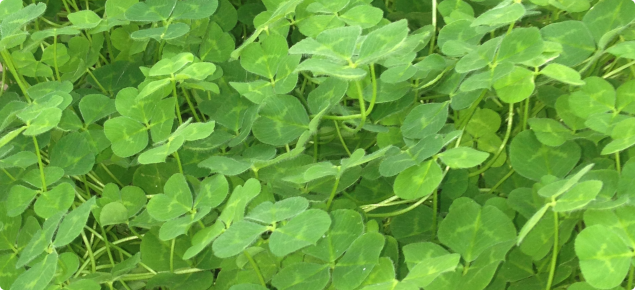Origin
Tammin is derived from a complex cross involving the variety Dalkeith, three naturalised strains collected in WA and a wild plant collected in Sicily with RLEM seedling resistance. It was the most productive and persistent of 18 early flowering breeding lines and six commercial varieties in trials in WA at Tammin and Katanning (two trials) and two sites in eastern Australia.
Varietal characters
Tammin flowers approximately 88 days from an early May sowing in Perth (Table 1). It has only trace levels of the oestrogenic compound, formononetin, and will not cause infertility problems in ewes. Tammin suffers markedly less RLEM cotyledon damage than other early flowering varieties. Tammin is also considerably more hardseeded than other varieties, resulting in greater persistence in crop rotations. Table 1 shows the proportion of seed set remaining as hard seeds in May following placement on the soil surface in Perth. Hard seed breakdown over four summers on the soil surface is shown in Figure 1. After four summers Tammin still had 7.7% of its original seed as hard seeds, while all other cultivars had <1% still hard after only three summers.
| Variety | Flowering time | Formononetin | RLEM damage | Hardseededness |
|---|---|---|---|---|
|
| (days from sowing in Perth) | (% of dry matter) | (% cotyledon silvering) | (% hard seeds in May after 5 months on the soil surface) |
| Tammin | 88 | 0.0 | 6.1 | 51.3 |
| Dalkeith | 96 | 0.0 | 39.2 | 16.3 |
| Geraldton | 88 | 1.1 | 40.8 | 20.3 |
| Izmir | 80 | 0.1 | 27.9 | 21.7 |
| Losa | 95 | 0.1 | 28.3 | 9.3 |
| Nungarin | 77 | 0.1 | 32.9 | 23.7 |
| Urana | 105 | 0.0 | 25.4 | 24.3 |
Field performance
Across all sites and years Tammin had 7% higher autumn biomass than Dalkeith, 2% higher winter biomass, 17% higher spring biomass, similar seed yields in the year of sowing and maintained a 31% higher seed bank density in subsequent summer-autumn periods.
The real advantage of the higher hardseededness of Tammin was apparent in the Tammin and Katanning trials, which were cropped in the second year. Across both sites, Tammin retained 48% more seeds in the seed bank during the crop phase than Dalkeith, which resulted in a 34% higher seedling regeneration density, 9% more winter biomass and 56% more spring biomass (Figure 2).
Seed availability and PBR status
Seed of Tammin can be purchased through Seed Force agencies.
Tammin is protected under the Plant Breeders Rights Act 1994. Under the Act sale of Tammin seed can only be carried out by agreement with the licensee, Seed Force Pty Ltd. However, this does not restrict sale of produce, such as hay or silage, provided seed was legally purchased.
For seed sales information visit seedforce.com.au


